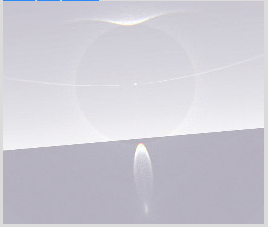Tangent Arc Images
Tangent Arc Images: A Captivating Atmospheric Phenomenon
Tangent arcs, also known as tangent arcs to the 22° halo, are a mesmerizing atmospheric phenomenon that adds a touch of magic to the sky. These ethereal arcs appear just below the horizon and are often accompanied by a stunning display of vivid colors. While they may be fleeting, lasting only a few seconds, their beauty is undeniable. In this article, we will delve into the world of tangent arc images, exploring their formation, characteristics, and the science behind their enchanting appearance.
The Formation of Tangent Arcs
Tangent arcs are formed when sunlight interacts with ice crystals in the atmosphere. These ice crystals can take various forms, such as hexagonal columns or plates, and are commonly found in high-altitude cirrus clouds. As sunlight passes through these ice crystals, it undergoes refraction and reflection, resulting in the creation of optical phenomena like halos, arcs, and even sun dogs.
The specific formation process of tangent arcs involves light rays entering through the side faces of the ice crystals and exiting through their basal faces. This unique interaction causes the light to deviate at a specific angle, ultimately giving rise to the tangent arc. The arc appears just below the 22° halo, creating a captivating visual spectacle for those fortunate enough to witness it.
Characteristics of Tangent Arcs
Tangent arcs exhibit several distinct characteristics that make them visually striking. Here are some key features to look out for when observing or photographing tangent arc images:
-
Position: Tangent arcs are located just below the 22° halo, forming a gentle curve along the horizon. The height of the sun in the sky determines the position of the top of the arc.
-
Color: These arcs often showcase a vivid display of colors, ranging from reds and oranges to blues and purples. The exact colors observed depend on the size and composition of the ice crystals, as well as the angle of the sunlight.
-
Duration: While tangent arcs can be incredibly brief, lasting only a few seconds, their intensity can vary throughout their existence. They may start off brilliantly bright but gradually fade away as time passes.
Photographing Tangent Arcs
Capturing the ephemeral beauty of tangent arcs through photography can be a challenging yet rewarding endeavor. To increase your chances of success, consider the following tips:
-
Be prepared: Tangent arcs can appear unexpectedly, so it's essential to have your camera ready at all times. Anticipate the moment and be ready to press the shutter button.
-
Optimal settings: Set your camera to a fast shutter speed to freeze the motion of the arc. Adjust the exposure settings to ensure the vibrant colors are accurately captured.
-
Composition: Experiment with different compositions to create visually compelling images. Incorporate elements such as landscapes or other atmospheric phenomena to add depth and interest to your photographs.
-
Patience and persistence: Tangent arcs are elusive and fleeting, requiring patience and persistence to capture. Don't be discouraged by missed opportunities; keep trying, and you may be rewarded with a stunning photograph.
Exploring the Science Behind Tangent Arcs
To fully appreciate the magic of tangent arcs, it's worth delving into the scientific principles that govern their formation. The intricate interplay between sunlight and ice crystals gives rise to these enchanting optical phenomena. By understanding the underlying physics, we can unravel the mysteries behind their captivating appearance.
The deviation of light rays as they pass through ice crystals follows Snell's law, which describes how light bends when transitioning between different mediums. The unique geometry of the ice crystals determines the specific angle at which light is refracted and reflected, resulting in the formation of tangent arcs.
Scientists and researchers continue to study and analyze the complex interactions between sunlight and ice crystals to deepen our understanding of tangent arcs and other atmospheric optics phenomena. Through advanced modeling and observation techniques, they aim to unlock the secrets of these captivating displays, shedding light on the beauty and intricacies of our atmosphere.
In conclusion, tangent arcs are a mesmerizing atmospheric phenomenon that enchants both the casual observer and the avid photographer. Their fleeting nature and vivid colors make them a sight to behold. By understanding their formation, characteristics, and the science behind their creation, we can truly appreciate the magic that unfolds in the sky. So, keep your eyes peeled, your camera at the ready, and immerse yourself in the captivating world of tangent arc images.

Photographed by Philip Laven of Geneva (site) while waiting to land at London on 9th March '01. "As we left the holding pattern, I saw a brilliant, vividly-coloured lower tangent arc just below the horizontal (the sun was 20� high so the top of the LTA was at about -2�. The manifestation lasted for less than 10 seconds and (as usual) the picture does not do it justice. When I first spotted the LTA, it was extremely bright but it had faded considerably by the time I got my camera into action - and had disappeared completely by the time my camera was ready for a second shot! Photo �Philip Laven.

Note: this article has been automatically converted from the old site and may not appear as intended. You can find the original article here.
Reference Atmospheric Optics
If you use any of the definitions, information, or data presented on Atmospheric Optics, please copy the link or reference below to properly credit us as the reference source. Thank you!
-
<a href="https://atoptics.co.uk/blog/tangent-arc-images-2/">Tangent Arc Images</a>
-
"Tangent Arc Images". Atmospheric Optics. Accessed on December 23, 2024. https://atoptics.co.uk/blog/tangent-arc-images-2/.
-
"Tangent Arc Images". Atmospheric Optics, https://atoptics.co.uk/blog/tangent-arc-images-2/. Accessed 23 December, 2024
-
Tangent Arc Images. Atmospheric Optics. Retrieved from https://atoptics.co.uk/blog/tangent-arc-images-2/.